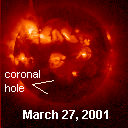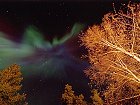|   SPACE WEATHER SPACE WEATHER
Current
Conditions
Solar Wind
velocity: 614.5 km/s
density:6.0 protons/cm3
explanation | more data
Updated: Today at 2247 UT
X-ray Solar Flares
6-hr max: C7 2025 UT Mar27
24-hr: M1 1630 UT Mar27
explanation | more data
Updated: Today at 2250 UT
Daily Sun: 27 Mar '01 
The large sunspot group 9393 has developed a delta magnetic field that could harbor energy for M-class or even X-class solar flares.
Sunspot Number: 339
More about sunspots
Updated: 26 Mar 2001
Radio Meteor Rate
24 hr max: 27 per hr
Listen to the Meteor Radar!
Updated: 27 Mar 2001 Interplanetary Mag. Field
Btotal: 19.3 nT
Bz: 3.3 nT south
explanation | more data
Updated: Today at 2247 UT Coronal Holes:

The only coronal hole on the Sun today is near the south pole; it is not favorably positioned to send solar wind streams toward Earth. Image credit: Yohkoh Soft X-ray Telescope.
More about coronal holes
 SPACE WEATHER SPACE WEATHER
NOAA
Forecasts
Solar Flares: Probabilities for a medium-sized (M-class) or a major (X-class) solar flare during the next 24/48 hours are tabulated below.
Updated at 2001 Mar 27 2200 UT
| FLARE | 24 hr | 48 hr | | CLASS M | 75 % | 75 % | | CLASS X | 20 % | 20 % |
Geomagnetic Storms: Probabilities for significant disturbances in Earth's magnetic field are given for three activity levels: active, minor storm, severe storm
Updated at 2001 Mar 27 2200 UT Mid-latitudes | 24 hr | 48 hr | | ACTIVE | 40 % | 30 % | | MINOR | 30 % | 20 % | | SEVERE | 10 % | 05 % |
High latitudes | 24 hr | 48 hr | | ACTIVE | 30 % | 40 % | | MINOR | 40 % | 25 % | | SEVERE | 20 % | 10 % |
| What's Up in Space -- 27 Mar 2001
Subscribe to Space Weather News!  SOLAR ACTIVITY ALERT: The Sun has entered a highly-active period with energetic sunspot growth all over the solar disk. Active region 9393 --one of the largest sunspots in years-- has a complex delta magnetic field that likely harbors energy for major X-class solar flares. You can see this huge sunspot for yourself, but be careful. Use a pinhole projector! Looking directly at the Sun can cause permanent eye damage. Click here to learn how to view the Sun safely. SOLAR ACTIVITY ALERT: The Sun has entered a highly-active period with energetic sunspot growth all over the solar disk. Active region 9393 --one of the largest sunspots in years-- has a complex delta magnetic field that likely harbors energy for major X-class solar flares. You can see this huge sunspot for yourself, but be careful. Use a pinhole projector! Looking directly at the Sun can cause permanent eye damage. Click here to learn how to view the Sun safely.
HERE COMES THE SUN: An interplanetary shock wave (probably the leading edge of a recent coronal mass ejection) buffeted Earth's magnetosphere on March 27th at 0130 UT. The impact did not trigger a strong geomagnetic storm -- but the next one might. Another coronal mass ejection (animation) is heading our way. It left the Sun on March 25th and could arrive as early as Tuesday night.  NORTHERN LIGHTS: Since March 19th when a coronal mass ejection hit Earth's magnetosphere, sky watchers in Alaska have enjoyed some of the best auroras in years. "The past two nights were absolutely incredible; beyond words," said veteran photographer Jan Curtis from Fairbanks on March 24th. To view recent aurora photos from Alaska and other parts of the world, please visit our AURORA GALLERY. NORTHERN LIGHTS: Since March 19th when a coronal mass ejection hit Earth's magnetosphere, sky watchers in Alaska have enjoyed some of the best auroras in years. "The past two nights were absolutely incredible; beyond words," said veteran photographer Jan Curtis from Fairbanks on March 24th. To view recent aurora photos from Alaska and other parts of the world, please visit our AURORA GALLERY.
NEAR-EARTH ASTEROID: MIT's LINEAR asteroid search program has discovered a new near-Earth asteroid. The space rock, named 2001 FO32, is approximately 1 km wide and will pass 65 lunar distances from Earth on March 28th. There is no danger of a collision. The asteroid will also swing by Mercury and Venus twice during the coming century. [3D orbit][ephemeris] WEB LINKS: NOAA FORECAST | GLOSSARY | SPACE WEATHER TUTORIAL | LESSON PLANS | BECOME A SUBSCRIBER | 
Potentially Hazardous Asteroids (PHAs) are space rocks larger than approximately 100m that can come closer to Earth than 0.05 AU. None of the known PHAs are on a collision course with our planet, although astronomers are finding new ones all the time. [more]
On 27 Mar 2001 there were 293 known Potentially
Hazardous Asteroids Upcoming Earth-asteroid encounters (Mar 1 - Apr 30) | Object | Date (UTC) | Miss Distance | | 2001 EC16 | 2001-Mar-23 16:00 | 0.0113 AU | | 2001 FO32 | 2001-Mar-28 19:47 | 0.1670 AU | | 1998 SF36 | 2001-Mar-29 18:37 | 0.0383 AU | | 1986 PA | 2001-Apr-03 01:06 | 0.1465 AU | | 2000 EE104 | 2001-Apr-12 20:37 | 0.0822 AU | 
- TOTAL LUNAR ECLIPSE: On Jan. 9, 2001, the full Moon glided through Earth's copper-colored shadow. [gallery]
- CHRISTMAS ECLIPSE: Sky watchers across North America enjoyed a partial solar eclipse on Christmas Day 2000 [gallery]
- LEONIDS 2000: Observers around the globe enjoyed three predicted episodes of shooting stars. [gallery]
 Feb. 21, 2001: Nature's Tiniest Space Junk -- Using an experimental radar at the Marshall Space Flight Center, scientists are monitoring tiny but hazardous meteoroids that swarm around our planet. Feb. 15, 2001: The Sun Does a Flip -- NASA scientists who monitor the Sun say our star's enormous magnetic field is reversing -- a sure sign that solar maximum is here. Jan. 25, 2001: Earth's Invisible Magnetic Tail -- NASA's IMAGE spacecraft, the first to enjoy a global view of the magnetosphere, spotted a curious plasma tail pointing from Earth toward the Sun. Jan. 4, 2001: Earth at Perihelion -- On January 4, 2001, our planet made its annual closest approach to the Sun. Dec. 29, 2000: Millennium Meteors -- North Americans will have a front-row seat for a brief but powerful meteor shower on January 3, 2001. Dec. 28, 2000: Galileo Looks for Auroras on Ganymede -- NASA's durable Galileo spacecraft flew above the solar system's largest moon this morning in search of extraterrestrial "Northern Lights" Dec. 22, 2000: Watching the Angry Sun -- Solar physicists are enjoying their best-ever look at a Solar Maximum thanks to NOAA and NASA satellites. MORE SPACE WEATHER HEADLINES |



